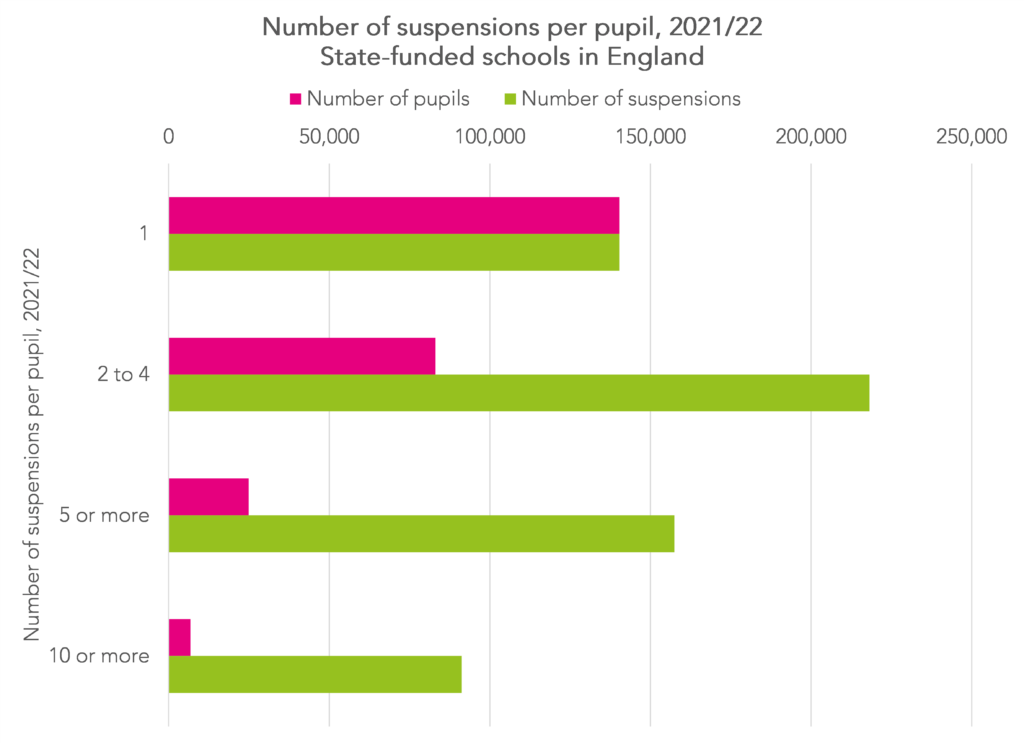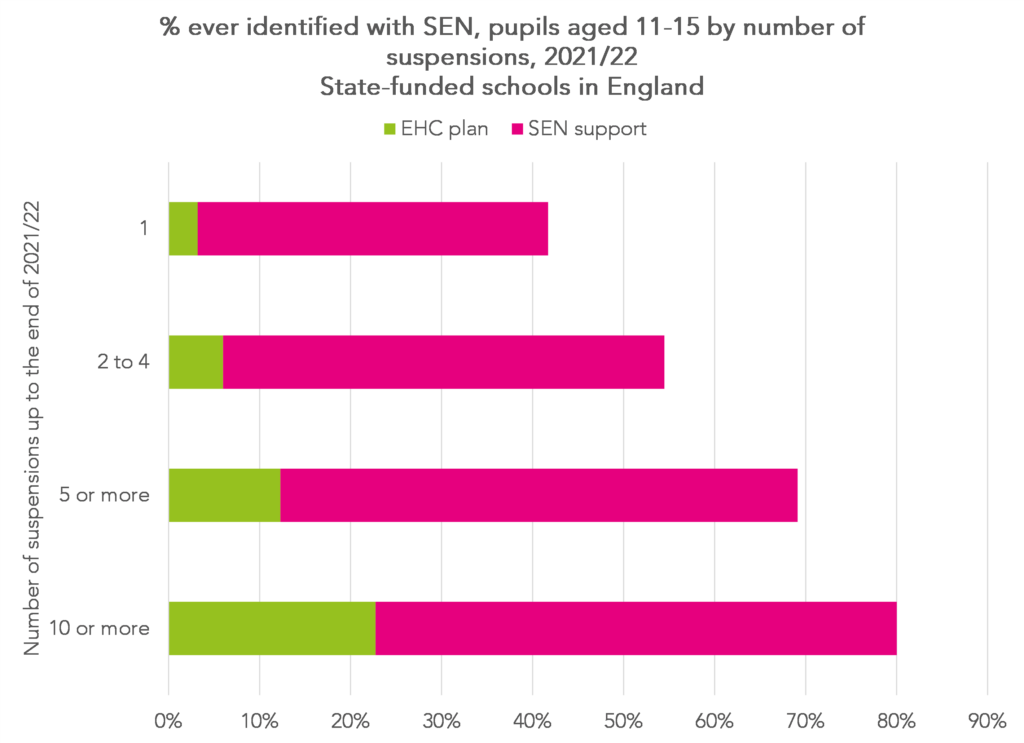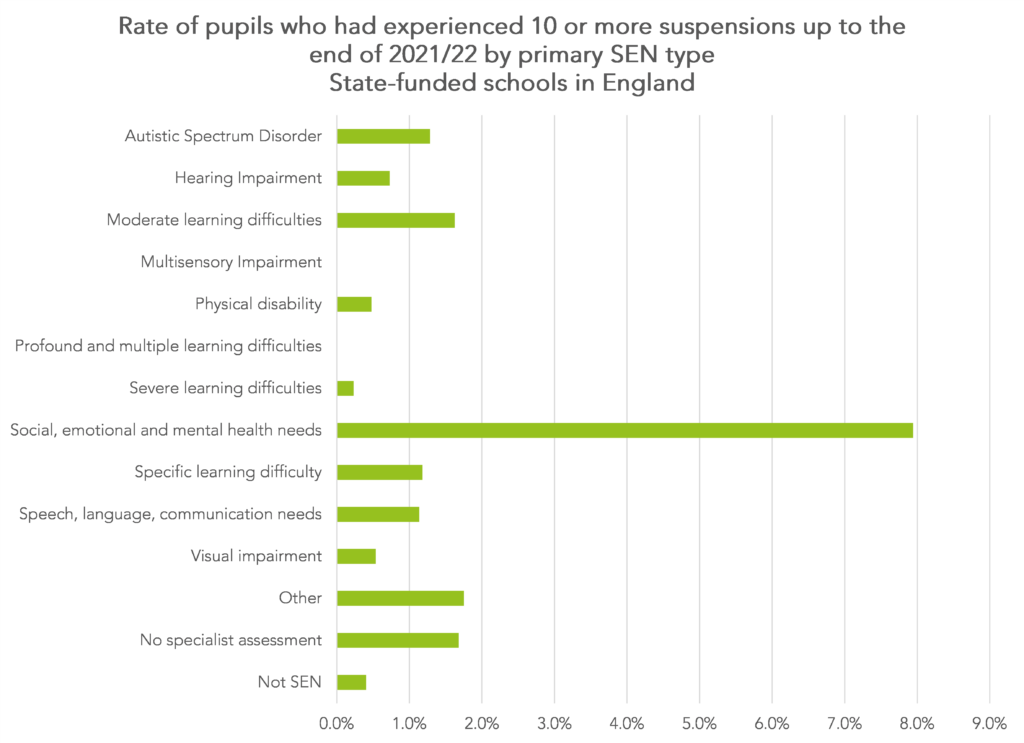In this article we’re going to examine the special educational needs (SEN) histories of young people who experience repeat suspensions, that is are suspended more than once during an academic year.
This follows a previous article in which we examined repeat suspensions from age 5 to 16 for a single cohort of pupils.
This time, we examine pupils who had repeat suspensions in 2021/22, the most recent year of exclusions data available for analysis. We also examine pupils who were suspended in 2021/22 given their history of suspensions up to the end of the previous year.
Data
We use data on exclusions from the National Pupil Database. We observe 607,000 suspensions for 2021/22. This is a slightly higher figure than appears in official statistics (578,280), even after removing possible duplicates.
For each pupil, we count the number of individual suspensions in 2022. We also count the number of suspensions for each pupil from their first enrolment in the state-funded school system in England up to the start of the 2021/22 academic year.
We then use School Census to observe the first year pupils were identified as having SEN. Within the group ever identified as SEN, we also observe the year first observed with a statement or education, health and care plan (EHCP), and the year first observed with a primary need of social, emotional and mental health (SEMH).
We also use School Census from 2022 to identify pupils’ current SEN provision and, for those with SEN, their primary SEN type.
Repeat suspensions in 2022
Overall, 255 thousand pupils experienced one or more suspensions in 2022, 7% of all pupils on roll.
140,000 pupils (55% of all those suspended) were suspended just once. These pupils accounted for 23% of all suspensions.
Fewer than 7,000 pupils (3% of all those suspended) were suspended 10 or more times in 2021/22. These pupils accounted for 15% of all suspensions.
Previous history of suspensions
We repeat the analysis, this time based on the number of suspensions pupils had experienced by the start of 2021/22.
Almost 280,000 suspensions (46% of all suspensions in 2022) were of pupils who had never been suspended before the start of the academic year. As we showed in our previous article, pupils who experience suspension for the first time tend to be suspended again at some point in their school career.
Over half of all suspensions in 2022 (54%) related to pupils who had experienced suspension at least once prior to the start of the academic year.
Most suspensions relate to pupils of compulsory secondary school age (11 to 15). We can see that the bars shorten only slightly when we remove other pupils from the chart.
For the remaining analysis, we focus on 11 to 15 year olds.
SEN histories
For 11 to 15 year olds who experienced suspension in 2022, we add suspensions from 2022 to those from previous years.
In the following chart, we show the level of SEN provision (as at the end of 2022) for 11 to 15 year olds who experienced suspension in 2022.
62% of pupils with 10 or more suspensions by the end of 22 were identified as having SEN. This compares to 22% of those who had experienced suspension just once.
Some pupils had previously been identified as having SEN but were not identified as such in 2022.
80% of pupils with 10 or more suspensions by the end of 2022 had been identified as having SEN at some point in their school career. This suggests 18% were no longer identified as having SEN in 2022.
Similarly, 42% of pupils with just a single suspension by the end of 2022 had been identified as having SEN at some point. This suggests that 20% were no longer identified as such.
For the group with at least 10 suspensions, we show when their first SEN identification occurred in relation to their first suspension. Negative numbers indicate that SEN identification occurred first
For the most part, pupils with multiple suspensions had been identified as having SEN prior to their first suspension. 57% were identified as having SEN prior to their first suspension, 9% in the same year and 13% following their first suspension. 20% had never been identified as having SEN.
Primary SEN type
Of the 25,600 pupils with at least 10 suspensions by the end of the 2022 academic year, almost 10,000 (39%) were identified as having social, emotional and mental health needs as their primary type of SEN. A further 14% had been identified as SEMH at some point previously in their school career.
In the final chart, we express the numbers in the green bars as a proportion of the total school population aged 11 to 15 in January 2022.
Almost 8% of all pupils with SEMH needs had been suspended at least 10 times by the end of 2021/22. Rates for other primary SEN types are much lower- all are below 2%. However, rates are 3 to 4 times higher compared to the group not identified with SEN for many groups, including autistic spectrum disorder, moderate learning difficulties and specific learning difficulty.
Summing up
In any given year, relatively few pupils experience suspension. In 2021/22, around 7% of pupils on roll in England’s schools were suspended at least once. Early indications are that this figure increased in 2022/23.
More than half of those pupils experienced just one suspension in 2021/22. Pupils with 2 or more suspensions accounted for 77% of all suspensions. 7 thousand pupils accounted for 15% of all suspensions. These pupils were each suspended at least 10 times in 2021/22.
62% of pupils aged 11-15 with 10 or more suspensions up to the end of 2021/22 were identified as having SEN in 2021/22, with 80% identified at any point in their school career. Corresponding figures for pupils with just 1 suspension were 22% and 42% respectively.
For those with at least 10 suspensions, the majority had first been identified as having SEN before their first suspension, with 50% identified at least 2 years before their first suspensions. However, what sort of support they received is unknown.
Want to stay up-to-date with the latest research from FFT Education Datalab? Sign up to Datalab’s mailing list to get notifications about new blogposts, or to receive the team’s half-termly newsletter.















This is an interesting analysis, though I confess it took me a little while to figure out the meaning of the green bars in the first graphs. Do these data include maintained special schools as well as maintained mainstream schools?
Thanks Claire. Yes, we’ve included all state-funded schools including special.
The problem is teachers are trained to teach the curriculum and not the child, plus all the rhetoric top down is curriculum, curriculum, curriculum. I help teachers to develop expertise in adaptive teaching and the true concept of adaptive teaching is so alien to the didactic style of pedagogy which is widespread and ineffective for children with barriers to learning. The curriculum is universally delivered irrespective of the knowledge strengths and weaknesses in a class, deliberate practice now drives a a universal style of teaching and quality assurance of lessons all too often look for universal routines. If adaptive teaching principles were applied top down, this data would decline significantly and children with barriers to learning would have better outcomes.